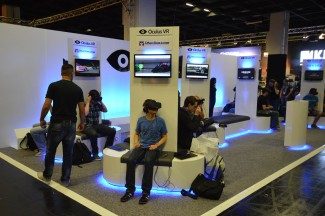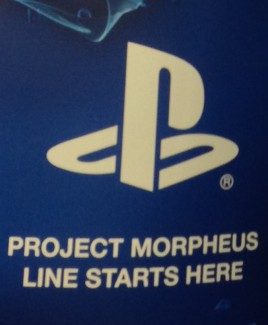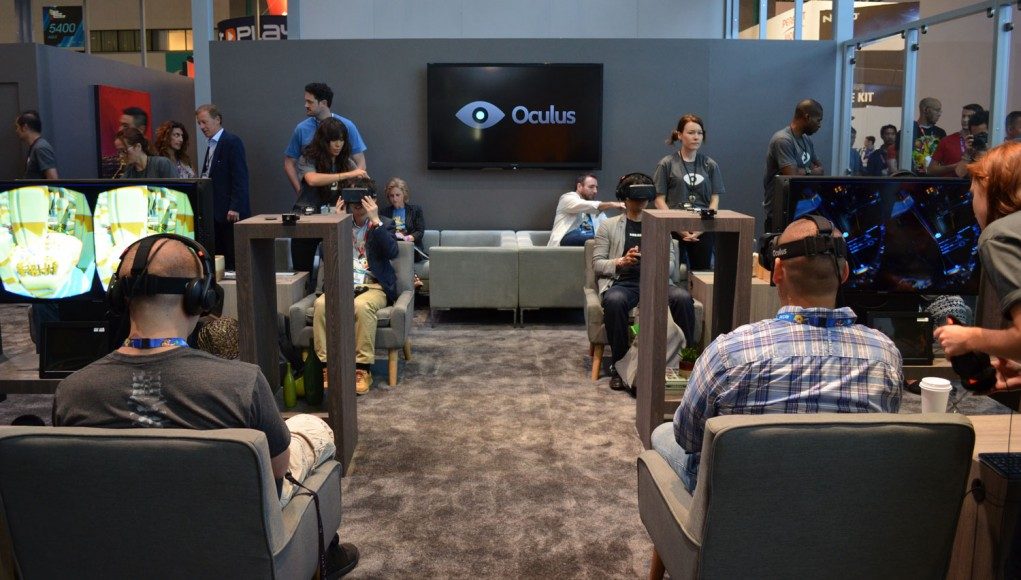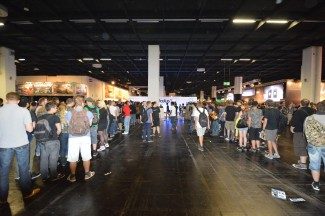2. Content (The Demo)
 I will not touch on which of the numerous games and demos available for VR platforms is the best to use—that is a whole feature in its own right. The fundamentals however include avoiding wide sweeping motion and complicated controls and objectives. I will touch on the three types of content that work best:
I will not touch on which of the numerous games and demos available for VR platforms is the best to use—that is a whole feature in its own right. The fundamentals however include avoiding wide sweeping motion and complicated controls and objectives. I will touch on the three types of content that work best:
- Exploration – travelling around an environment, looking at scenery and environments (passive as well as interactive)
- Completion of Task – using interface to complete a simple operation to a set goal
- Simple Game Narrative – based on a game genre with a simple beginning and end game metric
An aspect of using the ‘game’ approach is the creation of ‘competition’ and repeat visitation. Some booths actually run high-score tables each day, with the overall winner receiving a prize. This approach most commonly has been done with corporate exhibition booths, as a means to collect user details (name, email, etc.,) to be approached later with marketing material.
This brings us to the ‘duration’—how long is a good demonstration? The main aim is what you hope to achieve with the demo: just getting people to experience what wearing and using a VR headset is like, showing off a new game or experience, or promoting a particular product or service. Either way, to address the issue of disorientation for those who are having their first time experience in VR (which the majority of those at your booth will be), an impactful experience of approximately two minutes is best (including loading time and ‘head-time’).
Regarding ‘operation’, the demo needs to be easy to restart—especially if the experience is stopped by the users—and also the ability to reboot the system simply if there are issues. Bad power at a conference facility is not uncommon and the ability to simply reboot the hardware is worth considering. Also ensure that the system does not need an internet connection unless you are certain you will have access.
Also be aware that the demo will have to be simple enough to traverse that the operator can easily explain the objectives to the users while loading. If it takes longer than the experience to explain what you are meant to be doing, then there is something wrong!
3. Queue/Line (The Audience)
The managing of how users arrive at the stations is essential—many demonstrations of VR are literally overwhelmed by interest with queue-lines magically forming in front of the booth where the systems are operating. There is a need to have some planning prior to starting however to avoid problems.
It is a good idea to have a rope line that can be extended or shortened depending on crowds—also it is good to have the queue-line laid out so that passing audience can get to see the station and demonstration in process, and also that the line gets to see the demos (hopefully hearing the briefing from the operators helping with the process when it comes to their turn).
This also brings us to the issue of informing those before they enter the queue-line—’signage’ can be essential at this point—and I don’t mean large amounts of text, especially as many people you see at international events will not have English as their first language, if at all. Inform on the time to ride, inform on what you need to do and advise that if they are pregnant, have susceptibility to motion sickness, or have prior health issues that this may not be best for them. The use of symbols for much of this information is best (as they can often be more universally than foreign languages).
 Along with these if you want to avoid certain groups you inform them now rather than when they get to the station. If you are running a height- or age-restriction, run it here (the Oculus VR statement on children under 7 years old can apply here). Also issues of glasses, hair, and that you will not be demoing to people that are clearly intoxicated. This signage in the queue-line, and at the station, should include a little disclaimer stating that the operators take no responsibility for injury—in a litigious society it is best to protect yourself from possible problems, (this is not DisneyLand but let’s be professional).
Along with these if you want to avoid certain groups you inform them now rather than when they get to the station. If you are running a height- or age-restriction, run it here (the Oculus VR statement on children under 7 years old can apply here). Also issues of glasses, hair, and that you will not be demoing to people that are clearly intoxicated. This signage in the queue-line, and at the station, should include a little disclaimer stating that the operators take no responsibility for injury—in a litigious society it is best to protect yourself from possible problems, (this is not DisneyLand but let’s be professional).
4. Operation (Loading & Unloading)
The process of allowing people to don the VR system and become comfortable to the synthetic environment and the experience they are involved with takes a measured approach. This is something that has to be manned, with each station needing an attendant. These individuals need to be briefed on what to do and what not to do and their responsibilities, but also importantly on what to do if they have a problem.
Issues that the operator needs to be briefed on also include the issue of dealing with those that may have not read the signage, before taking the demonstration:
- Personal Items – As many demos are done at shows, the ability to have a clearly visible area to place belongings before starting is essential
- Wearing glasses – Dependent on the decision made for the VR headset usage you will have to handle those that need to lay down their glasses
- Hair ties / ‘Scrunchies’ – Informing the users on how to have their hair so that any straps will fit best
- Make adjustments to fit – Ensuring comfort and able to help the guest achieve this
- Explain what to expect – Being able to tell the user what they can expect from the demo and how best to operate or achieve the best results
- Explain what to do if uncomfortable – Being able to tell the user what to do if uncomfortable
Creating a routine to place the VR headset and then the audio systems on in the correct order and then show the user their interface unit are essentials. The ‘loading’ of the user into the experience will become a rhythm, as will the unloading of the process in reverse. Best to ensure this is simple and does not involve too much confusion that can tangle wires and disorientate the user. One aspect that should be also considered is the supplying of briefing notes, a hard copy of the key items that operator needs to remember—even including a trouble guide, and even the names of those people on the booth to ask for any help who are authorized.








